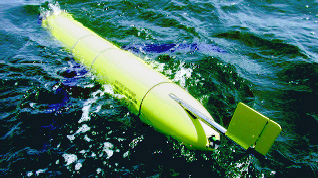Copper Vital in Oceanographic Research
There are vital copper components in Slocum Gliders, the unique, unmanned, oceanographic research vessels created by Webb Research Corporation, East Falmouth, Massachusetts. The latest Glider is a self-propelled, 6.5-foot-long vessel designed to cruise for five years in a vertical zig-zag path down to ocean depths of about 5,000 feet and back up.
It will measure salinity and temperature, plot currents and eddies, count microscopic plants and even record whale conversations. An earlier battery powered model (see photo) is used to study coastal waters up to 656 feet in depth for up to 30 days per investigation. This automated, undersea vessel (AUV) Glider was conceived of in 1989 by Douglas Webb. Both vessels are named after Captain Joshua Slocum, who in 1898 became the first man to circumnavigate the world solo.
 The first Glider, a battery-operated, unmanned research vessel designed to probe coastal waters to depths of up to 656 feet for up to 30 days per investigation. It is 6.5 feet long.
The first Glider, a battery-operated, unmanned research vessel designed to probe coastal waters to depths of up to 656 feet for up to 30 days per investigation. It is 6.5 feet long.Two prototypes of the new model, called the Slocum Thermal Glider, are now being tested in the ocean off Bermuda by scientists from the Woods Hole (Massachusetts) Oceanographic Institution. If this Thermal Glider lives up to expectations, hundreds of them will be launched in all the oceans of the world except in the Arctic and Antarctic (they won't work in very cold surface water). Compared to multi-milliondollar space vehicles (see " Copper Spacecraft to Thrill the World" in Copper Topics No. 88), they are a bargain at only $50,000 apiece.
The new Glider is the latest product of Webb Research. Founded in 1982, this company is devoted to creating oceanographic research instruments. Its other products, used by scientists all over the world, include the APEX buoy like devices that drift at a 6,700-foot depth and surface every 10 days to transmit data.
Bronze Bearing Material Used
 A crucial bronze component for the steering system of the Thermal Glider was chosen because it is self-lubricating and not subject to galling.
A crucial bronze component for the steering system of the Thermal Glider was chosen because it is self-lubricating and not subject to galling.According to Clayton Jones, a project engineer with Webb Research, C93200 bronze was chosen for a critical component in the Glider's steering assembly and pitch control. Because of its anti-galling (not seizing because of friction) properties, "it is being used as a supporting nut for a steel lead screw where it acts as a self-lubricating bearing surface" (see photo). The antennas, through which gathered data is transmitted up to communication satellites during the Glider's brief surfacings, are made of adhesive-backed C66500 copper sandwiched in the vessel's tail fin along with solid-core copper coaxial feeds. In addition, there are copper wires in the vessel's instrumentation, acoustic pinger and communications. The wires and cables were supplied by Component Distributors, Andover, Massachusetts.
The up and down transit of the Thermal Glider is activated by the difference in the oceans' temperatures at the surface and its maximum depth. It does contain rechargeable, alkaline "C" size batteries to power engine valves and the electronic instruments and communications. The supplier for the bronze components in the Gliders is McMaster-Carr Supply Co., Atlanta, Georgia.
Component Distributors: 978-475-6286
McMaster-Carr: 404-346-7000
Webb Research: 508-548-2077
Woods Hole: 508-548-1400
Also in this Issue:
- Copper Dominates Power Generation
- Treading on History
- Copper Vital in Oceanographic Research
- Copper Powers "New Generation" Trolleys
